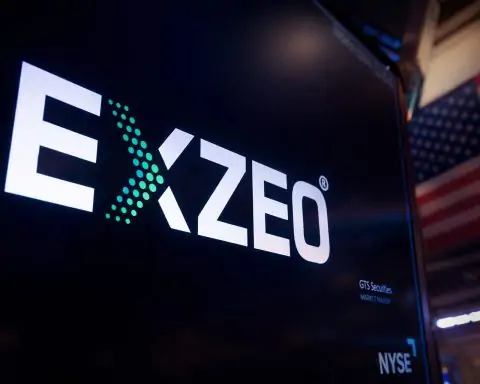Key Takeaways
- Stocks Defy Shutdown: Despite a U.S. government shutdown extending into a second week, the S&P 500 and Dow Jones Industrial Average notched record highs, buoyed by optimism around Federal Reserve rate cuts [1] [2]. The Nasdaq lagged slightly as tech shares wavered [3].
- Mixed Sector Moves:Tech stocks were choppy – chipmaker Applied Materials slid ~3% after warning of a $600 million sales hit [4], while utilities surged as investors shifted to defensive plays [5]. Rare earth shares spiked on hopes of U.S. government support [6], and Tesla hinted at a new affordable EV model, stirring investor excitement [7].
- Macroeconomic Data Delayed: Key reports like September’s jobs report were postponed due to the federal shutdown, forcing traders to rely on private indicators. Notably, an ISM survey showed U.S. service-sector employment contracted for a fourth straight month [8] – reinforcing signs of a cooling labor market even without official data.
- Fed Rate Cuts Expected: Markets are almost certain the Federal Reserve will cut interest rates in late October, with strong odds of another cut in December [9]. Bank of America pulled its forecast for the next cut forward to October, citing softer labor trends [10]. Still, Fed officials remain split: some urge aggressive easing, while others warn persistent inflation makes them cautious [11] [12].
- Earnings & Guidance: Though the Q3 earnings season is just beginning, guidance is already moving stocks. Applied Materials’ downbeat outlook hit chip stocks [13], and Tesla’s upcoming product event has bulls hoping for a boost [14]. In healthcare, Eli Lilly announced a major $1B manufacturing investment abroad as companies navigate growth plans [15].
- Global Forces at Play: Overseas developments fueled market swings. Japan’s Nikkei index soared 5% to an all-time high after a pro-stimulus leader was elected, tanking the yen [16]. Meanwhile, oil prices rebounded ~1% after OPEC+ approved only a token supply hike – easing glut fears [17] [18]. Gold spiked to a record $3,944/oz and Bitcoin breached $125,000 as investors flocked to safe havens amid global uncertainty [19] [20].
Market Performance: Rally Continues Amid Uncertainty
Wall Street extended its rally in the face of political gridlock. Last week, the S&P 500 and Dow each rose ~1.1%, and the Nasdaq gained 1.3%, with the S&P and Dow closing at record highs on Friday [21]. Monday’s trading opened on a strong note as well – S&P 500 futures were up about 0.3% early in the day, on track to add to those gains [22]. “It certainly feels like momentum is on the side of investors over the last few days,” said Mona Mahajan, head of investment strategy at Edward Jones [23]. She noted that traders have been increasingly betting on Federal Reserve rate cuts as economic data softens, even with Washington in disarray. The ongoing government shutdown, now past the one-week mark, has not derailed bullish sentiment so far.
Indeed, investors largely “look past government shutdowns” since short standoffs historically have minimal market impact, according to Anthony Saglimbene, chief market strategist at Ameriprise Financial [24]. Volatility remained contained – the modest 0.01% uptick in the S&P 500 on Friday was enough for a new peak [25]. The Dow Jones Industrial Average climbed 0.5% to a record 46,519.72, while the Nasdaq Composite dipped 0.3% under pressure from tech stocks [26]. Still, the broader trend has been upward: eight of the last ten trading sessions saw U.S. indexes advance, reflecting resilient risk appetite. As Saglimbene cautioned, however, a protracted shutdown could “cloud” important economic data if agencies stay closed [27]. For now, though, Wall Street’s “buy the dip” mentality appears intact [28], and dip buyers quickly emerged even on days when early losses hit the tape.
Sector Highlights & Notable Stock Movers
Beneath the index averages, leadership rotated between high-flying tech and defensive plays. Early last week, mega-cap tech companies – especially in the AI space – added fuel to the rally. The Nasdaq’s mid-week climb was powered by heavyweight names like Nvidia, Apple, and Broadcom [29], which continue to benefit from investor enthusiasm around artificial intelligence and robust earnings. However, by week’s end tech momentum wavered. The semiconductor sector saw profit-taking after Applied Materials – a leading chip equipment maker – forecast a $600 million hit to its 2026 revenue due to U.S. export curbs, sparking worries about demand [30]. Applied Materials’ stock fell ~2.7% on Friday and helped pull the Philadelphia Semiconductor Index off recent highs. Even Tesla, often a bellwether for growth stocks, couldn’t buck the trend: its shares gave up early gains and closed down about 1.4% Friday [31], capping a choppy week. (Tesla had reported weaker-than-expected Q3 delivery numbers earlier, weighing on sentiment.)
On the flip side, defensive sectors caught a bid. The S&P 500 utilities sector jumped 1.2% on Friday, the day’s top gainer, as investors rotated into steadier dividend-paying stocks amid the Washington impasse [32]. Consumer staples and healthcare names also outperformed the tech-heavy Nasdaq. “It seems like the market is hedging a bit – a tale of two tapes,” noted one strategist, pointing to tech’s stumble versus strength in defensives. Energy stocks are another area to watch: with crude oil bouncing higher to start the week (more on that below), integrated oil majors and refiners got a pre-market lift on Monday.
Several individual stocks staged outsized moves on news catalysts. USA Rare Earth (USAR.O), a small-cap mining firm, surged 14% after its CEO told CNBC the company was in “close communication” with the White House [33] – a signal that the U.S. government may bolster domestic rare-earth suppliers to reduce reliance on China. The prospect of federal support sent other mining and materials names higher in sympathy. AES Corp (a utility) spiked 17% mid-week on takeover speculation [34], illustrating the market’s appetite for M&A plays. Meanwhile, France’s SEB SA – maker of Tefal cookware – plunged 22% after cutting its profit forecast due to weak demand, a reminder that not all corporate news is rosy [35]. Back home, Tesla created buzz over the weekend by teasing an October 7 event in a cryptic video, fueling anticipation that a lower-priced EV model could be unveiled [36]. Analysts say a truly affordable Tesla could be a “game-changer” to sustain the company’s sales growth. Tesla’s stock could see volatility around the Tuesday event, although its recent pullback shows investors are also mindful of high valuation and rising competition in the EV space.
Economic Indicators & Macroeconomic Data
Macroeconomic data releases came to an abrupt halt as the federal government shutdown forced statistical agencies to go dark. Crucially, the Labor Department did not release the September nonfarm payrolls report scheduled for Friday – a direct result of the budget impasse that began on Oct. 1 [37]. That left traders without the marquee jobs numbers that typically set market tone at the start of each month. “With no official government data available because of the shutdown, investors were monitoring information from other sources,” Reuters noted [38]. In place of the jobs report, markets parsed alternative indicators: a private-sector Challenger, Gray & Christmas survey showed a decline in announced layoffs, and ADP’s payroll report mid-week came in weaker than expected [39]. Taken together, these hinted that the labor market is loosening somewhat.
Another key data point did manage to surface: the ISM services index for September, released by a private institute. Investors homed in on the employment sub-index, which fell into contraction territory for the fourth consecutive month [40]. The ISM reported its services employment gauge dropped to 50.0 (from 52.0 prior) – right at the threshold between expansion and contraction – signaling that hiring in the vast services sector has essentially stalled out [41]. This reinforced the narrative of a gradual cooling in the job market. “The market is looking at all of that against the backdrop of what was already weak job data in recent months, to try to gauge the real path forward for the labor market from here,” observed Jim Baird, CIO at Plante Moran [42].
Inflation, for its part, remains above the Fed’s 2% goal – especially service-sector inflation, which several officials flagged as stubbornly high [43]. But with fresh government price data (like CPI) also delayed by the shutdown, the picture is murkier. The Bureau of Labor Statistics, Bureau of Economic Analysis, and Census Bureau have all suspended their reports during the funding lapse [44]. This gap in information could become problematic if the shutdown drags on. “The longer it goes…it means the data collection for really important reports could get delayed, or it could cloud some of the data we will eventually get,” Ameriprise’s Saglimbene warned [45]. In other words, an extended blackout might make it harder for policymakers and investors to discern real economic trends versus statistical noise [46]. For now, however, the market appears to be taking the data disruption in stride – perhaps reasoning that no news is good news if it gives the Fed more cover to cut rates.
Federal Reserve Signals: Dovish Bets vs. Cautious Voices
Investor expectations for Federal Reserve policy have shifted decisively toward easier money. In the bond market, Treasury yields pulled back from recent highs as traders braced for potential rate cuts. According to CME FedWatch futures, there is now a 98% probability the Fed will cut interest rates by 0.25% at its late-October meeting, and roughly a 90% chance of another quarter-point cut at the December meeting [47]. Essentially, markets are pricing in rate easing to continue in the coming months, after the Fed already delivered a cut in September. Supporting this view, Bank of America Global Research on Friday moved its Fed call to predict an October rate cut (versus prior forecast of December) [48]. BofA cited “signs of a softening labor market” and argued that even without the official jobs report, plenty of alternative data (like rising jobless claims and the ISM surveys) point to cooling conditions [49]. The risk now, BofA added, is the Fed might “over-ease” if it isn’t careful [50] – a reminder that too much stimulus could stoke another inflationary surge down the line.
Inside the Fed, however, opinions are divided. Doves on the Federal Open Market Committee are emphasizing the need to bolster growth as the economy slows, while hawks remain wary of declaring victory on inflation. This tension was evident in public remarks last week. Chicago Fed President Austan Goolsbee struck a cautious tone, saying the Fed is in “a bit of a sticky spot” with inflation still above target even as job growth weakens [51]. Goolsbee told CNBC that “you’re getting deterioration of both sides of the mandate at the same time” – referring to rising unemployment risk and still-elevated inflation – which complicates the case for aggressive rate cuts [52]. “I’m a little wary about front-loading too many rate cuts and just counting on the inflation going away,” Goolsbee said pointedly [53]. Several other regional Fed presidents have echoed this concern that inflation’s persistence, especially in wage-intensive service industries, could limit how fast the Fed eases up [54].
On the other side, newly installed Fed Governor Stephen Miran has been lobbying for a bolder approach to rate relief. Miran, a Trump-appointed official, argued that policy is currently “too tight” and that “if policy is out of whack, you should adjust it at a reasonably…brisk pace” [55]. In an interview, he pressed for steeper cuts sooner to counteract the economic impact of Trump administration policies (such as new tariffs and immigration restrictions) that Miran believes are weighing on growth [56]. This stance puts him at odds with the more cautious mainstream of the Fed. The upshot for markets is that the Fed’s next moves are highly anticipated: any hint that the October meeting might not deliver a cut, or conversely that a larger 50 basis-point cut could be on the table, would likely jolt both stocks and bonds. For now, though, investors seem convinced the Fed will err on the side of stimulus, especially with Washington’s fiscal dysfunction (the shutdown) adding a new wildcard. As one trader quipped, “Jay Powell might not have the data, but he has the market’s blessing to cut – and that’s half the battle.”
Corporate Earnings and Outlook
The U.S. stock market is also entering a pivotal earnings season, where corporate results and guidance will either validate or challenge the market’s recent strength. The week of Oct. 5–6 was relatively light on scheduled earnings, but a few notable corporate updates grabbed headlines:
- Applied Materials (AMAT) – The semiconductor equipment giant delivered an unwelcome surprise by announcing it expects to lose $600 million in revenue next year due to U.S. export regulations limiting sales to China [57]. This cautious guidance, coming ahead of AMAT’s official earnings, rattled the chip industry. Shares of AMAT fell ~3%, and peers like Lam Research and KLA also slumped on fears that geopolitical tensions are denting their long-term growth prospects. The news underscored how export curbs and U.S.-China decoupling remain a risk for tech manufacturers.
- Tesla (TSLA) – Elon Musk’s EV titan wasn’t reporting earnings yet (Tesla’s Q3 report is due later in October), but it still captivated the market’s attention. On Sunday, Tesla teased a mysterious event for Tuesday, Oct. 7, posting a nine-second video of an unseen vehicle with headlights glowing [58]. The teaser, along with a “10/7” date flash, has fueled speculation that Tesla will finally unveil its long-rumored affordable model (sometimes dubbed the Model 2) aimed at the mass market. Investors and analysts are anxiously awaiting details – a truly lower-cost Tesla could massively expand the company’s addressable market. Tesla’s stock, which has been volatile recently, could see a boost if the event impresses. However, Tesla also faces near-term questions after reporting only 435,000 deliveries in Q3 (below estimates) and cutting vehicle prices again in the face of rising competition. How Musk balances growth vs. margins is a key storyline this quarter.
- Big Banks and Others – The earnings season formally kicks off later in the week with major banks like JPMorgan and Wells Fargo set to report, followed by tech heavyweights later in October. Although these results fall just outside the Oct. 5–6 window, investors are already positioning. Financial stocks ticked higher last week on anticipation that lower interest rates could spur loan growth and ease pressure on borrowers. On the flip side, oil companies may see mixed results – crude prices have slid in recent months (until this week’s OPEC bounce), possibly squeezing Q3 profit margins for energy producers. Another space to watch is pharmaceuticals: in an announcement Monday, Eli Lilly said it will invest over $1 billion in new manufacturing in India [59], a strategic move to globalize production of its in-demand drugs. The pharma sector has been strong, buoyed by breakthrough weight-loss treatments and oncology drugs, and Lilly’s expansion highlights confidence in future demand. Any guidance on drug pricing or regulatory changes (like potential new Medicare rules) will be closely parsed by the market.
Overall, analysts expect moderating earnings growth for S&P 500 companies this quarter, given higher costs and a slowing economy. But so far, corporate America’s messaging has been cautiously optimistic – many firms are managing to maintain profitability through cost cuts and pricing power. If that trend holds, it could provide another leg of support to a market at record highs. Conversely, any high-profile earnings misses or negative outlooks (especially in tech or consumer sectors) could test the market’s resilience.
Global & Geopolitical Events Impacting Markets
Global developments from Tokyo to the Middle East played into U.S. market sentiment during October 5–6. Perhaps the biggest overseas surprise came from Japan, where a political upheaval unleashed a bullish wave. Over the weekend, Sanae Takaichi, a noted fiscal and monetary dove, won the ruling party’s leadership race – positioning her to become Japan’s first female Prime Minister [60]. Investors cheered the outcome: Japan’s Nikkei 225 stock indexsoared over 5% on Monday to breach the 48,000 level for the first time ever [61]. Expectations that Takaichi will push expansive fiscal stimulus and go easy on the Bank of Japan’s tightening plans sent Japanese equities rocketing. Correspondingly, the yen tumbled to multi-year lows (beyond ¥150 per USD) as traders anticipated even looser policy [62]. Japanese government bond yields saw divergent moves – long-term yields hit record highs on fears of debt-funded spending, while short-term yields fell as bets of near-term BOJ rate hikes diminished [63]. The ripple effect in U.S. markets was mostly positive: a booming Japan boosts global risk appetite, and a weaker yen contributed to a softer dollar against major currencies, easing financial conditions slightly [64].
In the Middle East, the ongoing conflict between Israel and Hamas remained a background concern. Over the weekend, President Donald Trump reportedly pressed Israeli Prime Minister Netanyahu to agree to a ceasefire in Gaza as civilian casualties mounted [65]. However, Israel’s government faces internal backlash from far-right factions against any halt in military operations [66]. The war (now several weeks old) has not caused major disruption in global oil supply or trade routes so far, which is likely why markets have been relatively insulated from its direct impact. Nonetheless, traders remain alert to any escalation that could roil energy markets or lead to broader geopolitical strife. Defense industry stocks in the U.S. have seen occasional boosts on headlines about increased arms support to Israel, but those moves were marginal in this period. Diplomatically, the U.S. is walking a fine line – any resolution (or expansion) of the conflict could have indirect effects on investor sentiment in the weeks ahead.
Perhaps more immediately felt was the news from OPEC+ (the Organization of the Petroleum Exporting Countries plus allies like Russia). In a virtual meeting on Sunday, OPEC+ agreed to increase oil production by just 137,000 barrels per day for November, sticking to the same modest monthly hike as in October [67]. This output boost was far smaller than some in the market had speculated (Saudi Arabia was rumored to favor as much as a 500,000+ bpd hike to regain market share) [68]. The restrained approach calmed fears of a supply glut. As a result, oil prices jumped on Monday: Brent crude climbed roughly 1% to about $65.20 a barrel [69], and WTI crude similarly rose 1.1% to $61.54 [70]. Energy analysts noted that extensive refinery maintenance in the Middle East and weak Q4 demand forecasts were already weighing on oil, so OPEC’s caution makes sense [71] [72]. “With the absence of any fresh bullish catalysts and growing ambiguity on the demand outlook, oil prices are likely to stay capped despite OPEC+’s smaller-than-feared output hike,” said one market strategist [73]. For U.S. markets, the oil uptick provided relief to the beaten-down energy sector, although consumers may see gasoline prices stabilize or inch higher after recent declines.
Finally, safe-haven assets had a standout performance amid the mix of U.S. political drama and global cross-currents. Gold prices exploded to all-time highs, reflecting strong demand for protective assets. Spot gold surpassed $3,900 per ounce for the first time ever on Monday [74]. It hit an intraday record of $3,944/oz before pulling back slightly, and was still around $3,926 in morning trade [75]. The shiny metal’s surge has been attributed to a perfect storm of factors: a slumping yen (historically gold-positive), jitters over the U.S. fiscal situation (with the shutdown underscoring political risk), and the prospect of Fed rate cuts (which lower the opportunity cost of holding non-yielding gold) [76] [77]. “Safe-haven demand [is] following a fall in the yen and [the] U.S. government shutdown,” as Reuters summarized the move [78]. Similarly, Bitcoin – often dubbed “digital gold” – went on an extraordinary run. The leading cryptocurrency rallied to a lifetime high, peaking around $125,653 on Sunday before settling near $123,600 on Monday [79] [80]. Crypto market watchers linked Bitcoin’s surge to the same drivers as gold’s: an appetite for assets outside the traditional financial system given U.S. government uncertainties. “The shutdown matters this time around,” observed Geoffrey Kendrick, head of digital assets research at Standard Chartered [81]. He noted that Bitcoin has been trading in line with indicators of U.S. government risk, such as the Treasury “term premium,” and predicted “Bitcoin will rise throughout the shutdown”, potentially reaching $135,000 if the stalemate continues [82]. Such a bold forecast underscores how bullish sentiment has become in the crypto space as investors seek uncorrelated havens. Of course, both gold and Bitcoin could pull back if the U.S. resolves its budget issues or if the Fed signals a more hawkish stance than expected. For now, though, they are flashing bright on traders’ radar screens.
Expert Outlook: Cautious Optimism with an Eye on Washington
Market experts generally agree that U.S. equities have shown remarkable resilience in the October 5–6 period, shrugging off concerns that might have rattled investors in the past. The consensus is that low interest rates on the horizon are a powerful tonic – effectively outweighing negatives like the shutdown or mixed economic data. “The market has historically shrugged off government shutdowns,” Saglimbene notes, and as long as this one is resolved in a matter of weeks, the economic impact should be negligible [83]. However, analysts caution against complacency. If the political brinkmanship in Washington escalates – for instance, heading toward a debt ceiling crisis after the shutdown – or if the Fed were to backtrack on rate cut plans due to an inflation surprise, volatility could quickly return.
For now, the path of least resistance seems upward. The S&P 500 is already up roughly 14% year-to-date [84] (as of Oct. 3) and sitting above 6,700 points [85], a level unthinkable a year ago. Many strategists have had to revise their year-end targets higher given the market’s momentum and the “goldilocks” narrative of cooling inflation + cooling labor market = Fed easing. “Momentum is on the side of investors,” as Mahajan put it [86], and dips have been viewed as buying opportunities rather than reasons to flee.
In terms of forecasts, some bulls believe the Dow and S&P can grind to fresh records by year-end, especially if earnings come in better than feared in Q3. The tech-heavy Nasdaq might face more turbulence due to its big 2025 run-up (nearly +18% YTD [87]) and sensitivity to interest rates, but any clear signal of Fed rate cuts could reignite the tech trade. On the other hand, bears point out that stock valuations are elevated – the S&P 500’s forward P/E has climbed above 23, its highest since 2020 [88] – and earnings growth is far from robust. If macro conditions deteriorate beyond what delayed data currently show, the market could be caught off guard. Additionally, geopolitical shocks (from a major escalation in the Middle East, for example) remain an ever-present risk that could send investors scurrying to safety.
In summary, the first days of October 2025 have delivered a potent mix of record-breaking rallies and undercurrents of risk. Wall Street is betting that the Federal Reserve will ride to the rescue once more with rate cuts, bridging the economy to a soft landing even as fiscal policymakers clash in D.C. Investors are navigating by whatever light they can find – be it private data or corporate guidance – until Washington flips the switch back on for official economic reports. As one trader quipped, “We’re flying a bit blind, but at least we know the Fed has our back.” The coming weeks will test whether this optimism is justified or if the market’s near-term fortunes turn on a dime. Stay tuned – in markets, as in politics, a lot can change in just a few days.
Sources: Reuters, Yahoo Finance, CaixaBank Research, Investopedia. [89] [90] [91] [92] [93] [94] [95] [96] [97] [98] [99] [100] [101] [102]
References
1. www.reuters.com, 2. www.reuters.com, 3. www.reuters.com, 4. www.reuters.com, 5. www.reuters.com, 6. www.reuters.com, 7. www.reuters.com, 8. www.reuters.com, 9. www.reuters.com, 10. www.reuters.com, 11. www.reuters.com, 12. www.reuters.com, 13. www.reuters.com, 14. www.reuters.com, 15. www.reuters.com, 16. www.reuters.com, 17. www.reuters.com, 18. www.reuters.com, 19. www.reuters.com, 20. www.reuters.com, 21. www.reuters.com, 22. www.reuters.com, 23. www.reuters.com, 24. www.reuters.com, 25. www.reuters.com, 26. www.reuters.com, 27. www.reuters.com, 28. www.reuters.com, 29. www.reuters.com, 30. www.reuters.com, 31. www.reuters.com, 32. www.reuters.com, 33. www.reuters.com, 34. www.reuters.com, 35. www.reuters.com, 36. www.reuters.com, 37. www.reuters.com, 38. www.reuters.com, 39. www.reuters.com, 40. www.reuters.com, 41. www.caixabankresearch.com, 42. www.reuters.com, 43. www.reuters.com, 44. www.reuters.com, 45. www.reuters.com, 46. www.reuters.com, 47. www.reuters.com, 48. www.reuters.com, 49. www.reuters.com, 50. www.reuters.com, 51. www.reuters.com, 52. www.reuters.com, 53. www.reuters.com, 54. www.reuters.com, 55. www.reuters.com, 56. www.reuters.com, 57. www.reuters.com, 58. www.reuters.com, 59. www.reuters.com, 60. www.reuters.com, 61. www.reuters.com, 62. www.reuters.com, 63. www.reuters.com, 64. www.reuters.com, 65. www.reuters.com, 66. www.reuters.com, 67. www.reuters.com, 68. www.reuters.com, 69. www.reuters.com, 70. www.reuters.com, 71. www.reuters.com, 72. www.reuters.com, 73. www.reuters.com, 74. www.reuters.com, 75. www.reuters.com, 76. www.reuters.com, 77. www.reuters.com, 78. www.reuters.com, 79. www.reuters.com, 80. www.reuters.com, 81. www.reuters.com, 82. www.reuters.com, 83. www.reuters.com, 84. www.investopedia.com, 85. www.reuters.com, 86. www.reuters.com, 87. www.investopedia.com, 88. www.reuters.com, 89. www.reuters.com, 90. www.reuters.com, 91. www.reuters.com, 92. www.reuters.com, 93. www.reuters.com, 94. www.reuters.com, 95. www.caixabankresearch.com, 96. www.reuters.com, 97. www.reuters.com, 98. www.reuters.com, 99. www.reuters.com, 100. www.reuters.com, 101. www.reuters.com, 102. www.reuters.com







